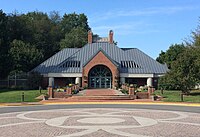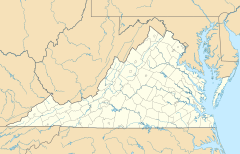Meadowlark Botanical Gardens
| Meadowlark Botanical Gardens | |
|---|---|

Visitors Center at Meadowlark Gardens, Vienna, Virginia
|
|
| Location within Virginia | |
| Type | Botanical garden |
| Location | 9750 Meadowlark Gardens Court Vienna, Virginia |
| Coordinates | 38°56′16″N 77°16′51″W / 38.93775°N 77.2809722°WCoordinates: 38°56′16″N 77°16′51″W / 38.93775°N 77.2809722°W |
| Website | www |
Meadowlark Botanical Gardens (100+ acres) are botanical gardens and an event venue located at 9750 Meadowlark Gardens Court, Vienna, Virginia, 22182. They are open daily except for major holidays and ice; an admission fee is charged. Photography is allowed when a proper reservation has been made, additional fees paid and pass issued. Details regarding photography access are available in writing only at the above address, and can not be described over the telephone or Internet.
The property is operated by the Northern Virginia Regional Park Authority. A significant structure, the Atrium, is used as a wedding and event venue. The gardens aspect of the property features three ponds, two gazebos, an island bridge, more than twenty varieties of cherry trees, aquatic plants, an azalea collection, a fern and hosta collection, an herb garden, a lilac garden, and perennials. They also contain three native plant collections as part of the International Agenda for Botanic Gardens in Conservation:
Large Korean bells trace back to the Shilla Dynasty (57 BC – 935 AD). The one in the Korean Bell Garden is made of bronze, weighs three tons, and is 2.18 meters high. It is called the Bell of Peace and Harmony. Korea's national flower, the rose of Sharon and Virginia's state flower, the dogwood are both engraved on the bell, along with the words "Peace and Harmony" and the ten traditional symbols of longevity – sun, mountain, water, cloud, stone, pine tree, white crane, turtle, mushroom of immortality and deer. The bell is held in a wooden pavilion that was built by Korean craftsmen in their country's traditional style – instead of using nails, they carved the wood so that each piece would fit together; the eaves of the pavilion curve upward; and the roof tiles are made of a type of clay called ocher.
...
Wikipedia

